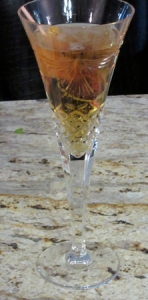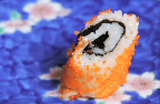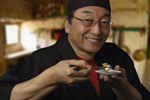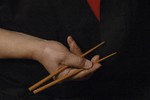As an part-time chef and storyteller, it is not unusual for me to use food as yet another medium (to try, at least) to connect to my fellow-man, to make a bridge between thought and reality.
What experience should have taught me is that be it photography, literature, film, or food, you gotta play to the right crowd.
 I have been known (sadly) to talk endlessly about how Joyce is sentence-by-sentence, the best writer of the last century…how Thoreau the most important and original. I can go on forever about my reasons for photographing the dolmens and burial tombs of Ireland…of how the interplay of light in nature may move me to almost ectasy…and how Japanese food is challenging, time-consuming and complex…and yet, at it’s very essence…simplicity and subtlety personified. I have to remind myself, that ‘tho I’m very passionate about all of these, it often means very little to your average person.
I have been known (sadly) to talk endlessly about how Joyce is sentence-by-sentence, the best writer of the last century…how Thoreau the most important and original. I can go on forever about my reasons for photographing the dolmens and burial tombs of Ireland…of how the interplay of light in nature may move me to almost ectasy…and how Japanese food is challenging, time-consuming and complex…and yet, at it’s very essence…simplicity and subtlety personified. I have to remind myself, that ‘tho I’m very passionate about all of these, it often means very little to your average person.

A couple of weeks ago, I got a birthday party invitation from my niece, Bryna’s 40th birthday. I haven’t cooked a big meal in a while so I offered to make a Japanese meal for the family as a gift. I knew this to be a substantial challenge as, my family would have little (if any) connection to Japanese food. However, I have been making dishes for the blog for a few years now, so I felt pretty sure of my limitations, as well as my strengths. I also had my ace-in-the-hole: Yoshio, and no one is better than bridging the East-meets-West cultures than him.
So, I dug in and created a menu that I thought would show Japanese food at its best, while catering (as best I could) to the Central New York palette.
Japanese Meal for the Family
Yoshio’s Salmon Ribbon: a piece of salmon, wrapped around a shiso leaf (sesame leaf) a little lemon zest, fresh dill, salt and white pepper. This is all wrapped in a won-ton noodle,which is then fried and covered in a raspberry jam/lemon juice/Grand Marnier sauce and topped with fresh raspberries.
Sliced Cucumbers: Small English cucumbers sliced thin with a dressing of mirin, rice vinegar, and sesame oil.
Broccoli and Lime-Mayo: Blanched and chilled broccoli crowns in a mayo, yoghurt, mirin, and lime sauce with fresh dill weed.
Tamago Roll: an egg omelette sweetened with mirin, fried, rolled and topped with chopped scallion.
Age Dashi Dofu: Tofu, dusted in corn starch and fried, in a broth of wakame and shiitake mushroom, topped with shredded scallion, daikon, and carrot.
Kushi Katu: small pieces of salmon, shrimp, chicken, beef, sweet potato, crimini mushrooms, onion and asparagus, on a stick, covered in a batter of panko and fried.
Temaki Roll: a cone of nori wrapped around sushi rice, with matchsticked carrot, scallion, daikon, crab meat, and cucumber.
Temari Zushi: a ball of sushi rice, covered with strips of avocado. Topped with grated carrot, daikon and toasted sesame seeds.
Macha Ice Cream: vanilla ice cream, slightly melted and mixed with powdered macha green tea and re-frozen.
The salmon ribbon was the appetizer, served with Yoshio’s “Mikan Cocktail” (champagne with a little plum-wine, garnished with a cherry and a slice of mikan [Mandarin orange.] ) We also had sake and green tea as well as a Japanese beer, rice crackers, and edamamae.
I had brought authentic Japanese music and my brother-in-law, Steve was kind enough to set it up on his music system. Both Steve and my sister, Mary Lou went halfsies with me on the meal, as a gift to Bryna and both did considerable prep-work for all the dishes.
A week before the meal, I met with Yoshio to concur with him on the menu. He approved and fine-tuned the dishes with good advice and a demonstration or two, to improve my technique. During my stay, he made a few dishes for me, one of which was a cold, silken tofu, garnished in shaved ginger on a bed of sauce that he made up on the spot. This dish was everything I wanted my family to experience: fresh, simple, unique and delicious.
Yet, I knew there going to be problems reconciling the Japanese diet with that of your average CNYorkers: for instance, the delicious silken tofu dish Yoshio made, would never fly with my folks. In fact, tofu was completely off the menu, until my niece told me that she loves tofu, so I included the age dashi dish (which only Bryna and I enjoyed, as the rest of the folks finding the idea of tofu repellent.)
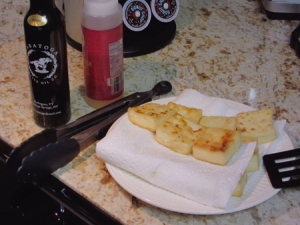 I also knew that I had not the training for, nor would the folks find appetizing, raw fish for the sushi. I actually brought a tube of wasabi, but as soon as I started serving food, I knew that wasabi would only detract from the experience.
I also knew that I had not the training for, nor would the folks find appetizing, raw fish for the sushi. I actually brought a tube of wasabi, but as soon as I started serving food, I knew that wasabi would only detract from the experience.
I had a few surprises of tastes that I now take for granted that I should have considered to be rather foreign to my family: green tea, for instance. No takers on that one (except, once again, my niece.) Sake, also was rather strange to them. A few people tried the warm rice wine and expressed surprise that it only had only the alcoholic content of wine (they all thought it was a liquor.) Any form of seaweed was right out: my sister tasted a seaweed rice cracker and pretty much retched at the taste. Anything wrapped in nori was not eaten.
 A big surprise was the disappointing response I got to my macha ice cream. I have made this a few times before and have gotten a favorable reactions from those that had never had it before: it’s only slightly sweet, but balanced by the slight bitter of he pulverized green tea mixed in. I caught my sister making a face after one spoonful, then she proceeded to lather the raspberry sauce from the salmon ribbon over the ice cream. In her defense, she is used to her very rich and sweet desserts she makes every Christmas, to great effect with her guests…so it stands to reason the subtleties of a Japanese dessert (which are invariably not as sweet) are lost on her.
A big surprise was the disappointing response I got to my macha ice cream. I have made this a few times before and have gotten a favorable reactions from those that had never had it before: it’s only slightly sweet, but balanced by the slight bitter of he pulverized green tea mixed in. I caught my sister making a face after one spoonful, then she proceeded to lather the raspberry sauce from the salmon ribbon over the ice cream. In her defense, she is used to her very rich and sweet desserts she makes every Christmas, to great effect with her guests…so it stands to reason the subtleties of a Japanese dessert (which are invariably not as sweet) are lost on her.
 My own mistakes did not help at all: I have forgotten that even ‘tho I’ve made all these dishes to perfection before, these Japanese dishes take practice! Although the taste was perfect, the shape and presentation of some of the sushi rolls could have been much better. I also could have done a better job with mastering my sister’s stove top (a technology I am not used to) better. The oil temperature was way too high.
My own mistakes did not help at all: I have forgotten that even ‘tho I’ve made all these dishes to perfection before, these Japanese dishes take practice! Although the taste was perfect, the shape and presentation of some of the sushi rolls could have been much better. I also could have done a better job with mastering my sister’s stove top (a technology I am not used to) better. The oil temperature was way too high.
Still…bless their hearts, my family showed up and took a leap and could very much appreciate the work involved in such a meal. Perhaps I should be most surprised that some of my dishes were tasted and appreciated! Sadly, those that were appreciated were mostly the creations of others (all of Yoshio’s recipes were liked, as well as Baba’s Temari Roll.)
 The world is an ocean of wonderful tastes, some from strange and foreign lands, just waiting for the stout sailor to brave the new horizons of culinary experience.
The world is an ocean of wonderful tastes, some from strange and foreign lands, just waiting for the stout sailor to brave the new horizons of culinary experience.
Thanks to my family for attempting this brief journey with me for an afternoon’s mini-adventure! I’ll be back with more delicious food (albeit more traditional fare) the next visit!
[One of the best things about a big meal like this is that I always end up relying on the contributions and input from others. Thanks to Steve and Mary Lou Swasey for being perfect hosts: their time, effort, remarkable prep-work skills…down to their ornamental china, which was perfect. Thanks to Steve for the photos of the day. Thanks also to Chris & Sara for their gift of the *best* sesame oil from the Saratoga Olive oil Co. and to Regan for the gift of dried shiitake mushrooms, and especially to Yoshio, for his recipes, good ideas, guidance, and for providing the rare supplies for the meal.]


